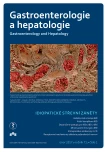When is celiac disease not celiac disease?
Authors:
Petra Koňaříková; V. Kojecký
Authors place of work:
Gastroenterologie, Interní klinika Krajská nemocnice T. Bati, a. s., Zlín
Published in the journal:
Gastroent Hepatol 2017; 71(1): 58-61
Category:
Klinická a experimentální gastroenterologie: kazuistika
doi:
https://doi.org/10.14735/amgh2016csgh.info18
Summary
Despite the high the prevalence of celiac disease in the European population (around 1%), this disease is often not diagnosed and in some cases the diagnosis takes place when the disease is in the advance stages. Diagnosing celiac disease is not always unequivocal and because it requires a lifelong gluten-free diet, it should be done in a sensible way. Diagnosing celiac disease is based on the conclusiveness of different serological markers and on the presence of a typical coeliac histology that responds to a gluten-free diet. In cases of typical disease progress, the diagnosis is usually clear. Doubts may arise when other diseases mimic the symptoms of celiac disease or when a non-standard or missing serological response occurs. Our case study describes a 30-year-old patient whose diagnosis of celiac disease could not be confirmed or refuted, even after several years of considerable effort. At the beginning of monitoring, the patient was diagnosed with celiac disease based on the presence of characteristic histological findings in a membrane biopsy of the duodenum (Marsh 3). Despite the patient maintaining a variable diet, the histological changes regressed but without loss of isolated positivity to endomysial antibodies. We therefore considered diseases other than celiac disease that might be responsible for the patient’s symptoms. Subsequently, lamblioza was confirmed in a secretion from the duodenum. Even after treatment, the patient was kept on gastroenterological dispenzarization and on a normal diet with working diagnosis of potential sprue.
Key words:
celiac disease – differential diagnosis – duodenitis – Giardia lamblia
The authors declare they have no potential conflicts of interest concerning drugs, products, or services used in the study.
The Editorial Board declares that the manuscript met the ICMJE „uniform requirements“ for biomedical papers.
Submitted:
25. 2. 2016
Accepted:
2. 4. 2016
Zdroje
1. Frič P, Keil R. Celiakie pro praxi. Med Praxi 2011; 8(9): 354– 359.
2. Kohout P. Celiakie v ambulantní praxi. Med Praxi 2007; 6: 250– 252
3. Walker-Smith JA, Guandalini S, Schmitz Jet al. Revised criteria for diagnosis of coeliac disease. Report of Working Group of European Society of Paediatric Gastroenterology and Nutrition. Arch Dis Child 1990; 65(8): 909– 911.
4. Kotalová R, Nevoral J, Šmídová J. Tkáňové protilátky v diagnostice celiakální sprue. Čs Pediatr 1996; 51(11): 680– 687.
5. Clemente MG, Musu MP, Frau F et al. Antitissue transglutaminase antibodies outside celiac disease. J Pediatr Gastroenterol Nutr 2002; 34(1): 31– 34.
6. Collin P, Kaukinen K, Vogelsang H et al. Antiendomysial and antihuman recombinant tissue transglutaminase antibodies in the diagnosis of coeliac disease: a biopsy--proven European multicentre study. Eur J Gastroenterol Hepatol 2005; 17(1): 85– 91.
7. Husby S, Koletzko S, Korponay-Szabó IR et al. European Society for Pediatric Gastroenterology, Hepatology, and Nutrition Guidelines for the diagnosis of coeliac disease. J Pediatr Gastroenterol Nutr 2012; 54(1): 136– 160. doi: 10.1097/ MPG.0b013 e31821a23d0.
8. Salmi TT, Collin P, Korponay-Szabó IR. Endomysial antibody‐negative coeliac disease: clinical characteristics and intestinal autoantibody deposits. Gut 2006; 55(12): 1746– 1753. doi: 10.1136/ gut.2005.071514.
9. Volta U, Granito A, Parisi C et al. Deamidated gliadin peptide antibodies as a routine test for celiac disease: a prospective analysis. J Clin Gastroenterol 2010; 44(3): 186– 190. doi: 10.1097/ MCG.0b013e3181c378f6.
10. Agardh D. Antibodies against synthetic deamidated gliadin peptides and tissue transglutaminase for the identification of childhood celiac disease. Clin Gastroenterol Hepatol 2007; 5(11): 1276– 1281.
11. Karell K, Louka AS, Moodie SJ et al. HLA types in celiac dinase patients not carrying the DQA1*05-DQB1*02 (DQ2) heterodimer: results from the European genetics cluster on celiac disease. Hum Immunol 2003; 64(4): 469– 477.
12. Polvi A, Eland C, Koskimies S et al. HLA DQ and DP in Finnish families with celiac disease. Eur J Immunogenet 1996; 23(3): 221– 234.
13. Margaritte-Jeannin P, Babron MC, Bourgey M et al. HLA-DQ relative risks for coeliac disease in European populations: a study of the European genetics cluster on coeliac disease. Tissue Antigens 2004; 63(6): 562– 567.
14. Heap GA, van Heel DA. Genetics and pathogenesis of coeliac disease. Semin Immunol 2009; 21(6): 346– 354. doi: 10.1016/ j.smim.2009.04.001.
15. Gujral N, Freeman H, Thomson AB et al. Celiac disease: prevalence, diagnosis, pathogenesis and treatment. World J Gastroenterol 2012; 18(42): 6036– 6059.
16. Degaetani M, Tennyson CA, Lebwohl Bet al. Villous atrophy and negative celiac serology: a diagnostic and therapeutic dilemma. Am J Gastroenterol 2013; 108(5): 647– 653. doi: 10.1038/ ajg.2013.45.
17. Pathological Society, Understanding Disease [online]. Available from: www.pathsoc.org.
18. Bai JC, Fried M, Corazza GR. World Gastroenterology Organisation global guidelines on celiac disease. J Clin Gastroenterol 2013; 47(2): 121– 126. doi: 10.1097/ MCG.0b013e31827a6f83.
Štítky
Dětská gastroenterologie Gastroenterologie a hepatologie Chirurgie všeobecnáČlánek vyšel v časopise
Gastroenterologie a hepatologie

2017 Číslo 1
- Metamizol jako analgetikum první volby: kdy, pro koho, jak a proč?
- MUDr. Lenka Klimešová: Multioborová vizita může být klíčem k efektivnější perioperační léčbě chronické bolesti
- Horní limit denní dávky vitaminu D: Jaké množství je ještě bezpečné?
- Realita léčby bolesti v paliativní péči v Německu
Nejčtenější v tomto čísle
- Kožní problematika u pacientů s idiopatickými střevními záněty
- Celiakie, která není celiakií?
- Ginkor Fort® s obsahem extraktu z jinanu dvoulaločnatého
- Mění se chirurgická léčba stenotického karcinomu rekta?
